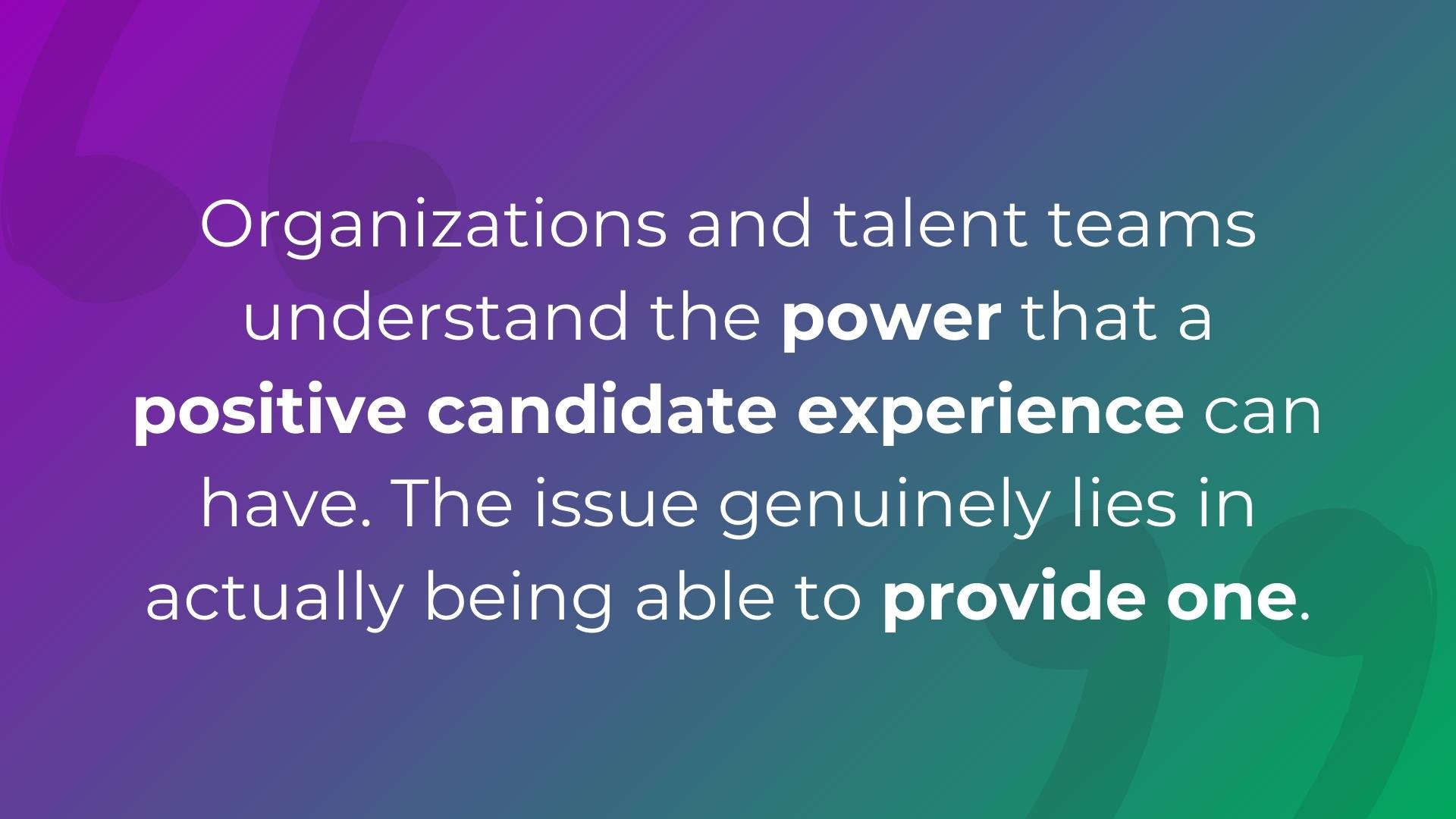Talent acquisition’s importance has never been greater. In an era defined by shortage and a need for skills, having the right people on your bench can truly mean the difference between success and struggle. And given this competitive market, one should assume that providing a positive candidate experience would be at the forefront of any organization’s hiring policy.
Yet, it seems this isn’t exactly the case.
In fact, paradoxically, the art of crafting a seamless and respectful recruitment process appears to be dwindling, and instead, candidate resentment is on the rise, as detailed in the latest ERE Global Candidate Experience Report:
“This year, the overall positive candidate experience, what we now call candidate contentment, declined sharply while candidate resentment, the very negative experience, increased globally.”
Review boards like Glassdoor are full of comments from former candidates detailing the numerous ways an organization dropped the ball in their hiring process. There are TikToks going viral doing exactly the same. Even anecdotally, we all have stories about how poor an interview process was – it’s a universal experience.
But why, with all the data and evidence available to support the need for a positive candidate experience, are hiring teams struggling to provide this? What are the primary causes of poor candidate experience at the moment? And how can we start to remedy it? Let’s get into it.

The Candidate Experience Conundrum
I think it’s fair to say that organizations and talent teams understand the power that a positive candidate experience can have. The issue genuinely lies in actually being able to provide one.
According to Careerplug research, 7 in 10 applicants pay close attention to the hiring process, and 52% will decline an offer after having a bad experience. But recruiters are currently under a lot of pressure to deliver more with less, and it’s no surprise that these conditions are negatively impacting candidate experience.
1. High Application Volumes
The digital age has democratized the application process, enabling job seekers from around the globe to apply with just a few clicks. This accessibility, while beneficial in broadening the talent pool, also leads to an overwhelming influx of applications. Recruiting teams, often not scaled proportionally to this surge, find themselves swamped, trying to sift through hundreds, if not thousands, of resumes. This high volume makes it exceedingly difficult to engage with each candidate meaningfully, often resulting in a generic and impersonal communication—or worse, no communication at all.
2. Leaner Recruiting Teams
Economic pressures and the ongoing push towards maximizing efficiency have led many companies to operate with leaner recruiting teams. These smaller teams are expected to perform the same tasks, with the same effectiveness, as their larger predecessors. The burden of increased demands on fewer shoulders can lead to burnout and errors, compounding the challenges of delivering a thoughtful candidate experience. Without sufficient manpower, even the most well-intentioned recruiters can struggle to maintain timely and personalized interactions at every touchpoint of the hiring process.
3. Underutilized Technology
Despite significant investments in recruitment technology, many organizations still underutilize these tools due to a lack of training, integration challenges, or simply the inertia of changing long standing processes. Technologies designed to enhance engagement, streamline communication, and manage applications more efficiently often lie dormant or are not used to their full potential. This underutilization not only wastes resources but also deprives candidates of a smoother, more interactive experience that could be achieved through proper technological empowerment.

Learn more: Check out our comprehensive playbook – How to Build the Perfect Candidate Experience.
What Elements of Candidate Experience are Applicants Finding Most Frustrating?
Let’s flip the script now. So we understand from a recruiting perspective why candidate experience is tough to optimize at the moment, but what about the applicants themselves? What is it that they’re finding so tough? According to SHRM, the three main reasons why candidates are withdrawing from the hiring process right now are:
- Their time being disrespected.
- Poor communication and no feedback.
- An overly long process.
There’s symbiosis here! Overworked, under-resourced, poorly optimized recruiters are always going to fall short when it comes to responding to candidates in a timely manner, or providing bespoke feedback. And while there isn’t always the capacity to do this for every applicant, it’s important to keep in mind, particularly if you’re hiring for critical roles.
SocialTalent’s candidate experience expert, Andrew MacAskill, states that:
“The idea that candidates can invest their time researching, preparing, and attending interviews, often at great expense, and never hear back, seems unthinkable. Yet it is more common than you might think.”
So how can organizations and talent teams work together to prioritize candidate experience in a realistic and scalable manner?
Quick Candidate Experience Wins
If poor candidate experience is an endemic pain point within your organization, these are a few actions you can take to help stem the tide and gradually build into a more sustainable approach.
1. Provide Recruiting Training
No one understands how transformative quality recruiting training can be like SocialTalent! We’ve enabled thousands of organizations to find, hire, and engage talent with our industry-leading recruiting training. Done right, recruiting training can enhance the skills and competencies of any talent acquisition team, directly impacting how they interact and manage candidates through the process.
Providing recruiting training can help teams align on what good looks like in terms of hiring, it can give them the tools needed to provide consistent candidate experience, and create a base level of ability that is rooted in best practice.
Learn more: Check out how SocialTalent has elevated these companies’ recruiting processes.
2. Manage Expectations
While rolling out recruiting training can seem like a more long-term solution, one thing you can do right now to improve the hiring experience is to manage candidate expectations.
We know that time is a critical concern for candidates, right? Being kept in the dark about when they are next going to hear from an interviewer, or when they’re going to receive feedback, or an offer can be so incredibly frustrating. And it’s not necessarily the amount of time that is most irksome – it’s the lack of clarity over when.
Maybe hiring volumes are high and the next touchpoint might not be for two weeks – tell your applicant this. Armed with accurate timescales there is considerably less friction when it comes to the process. Don’t tell them, and two weeks can feel like an eternity! It’s a small, psychological switch but can do wonders if you’re struggling with ‘poor time management’ feedback from candidates.
We spoke to Pfizer’s VP of Candidate Experience, Wendy Mayer, about this:
3. Write Accurate Job Descriptions
There is a growing trend with job descriptions not doing what they say on the tin. Whether they over-embellish on the requirements needed, smokescreen the actual expectations, or falsely promise the world, they are not giving candidates an accurate outlook at what the role is and this can have a huge impact on overall experience.
Instead, focus on creating a clear structure, keep language simple and inclusive, spell out what success in the role looks like, and give candidates a true sense of expectation. Sometimes we can get so caught up in the hamster wheel of recruiting that job ads become a slight copy and paste activity and this is where red flags should fly. Sacrifice a bit of extra time to ensure this text sings and save yourself the long-term hassle.
4. Empathy
Automations and AI are becoming an omnipresent component of the workplace. They have the potential to supercharge so many recruiting processes (and create more seamless interactions to help improve candidate experience) but too much tech can also be a negative.
The more we rely on automation to deal with candidates, the more we separate ourselves from the important act of relationship building. It feels like a lot of organizations and recruiters have forgotten what hiring feels like from the perspective of the candidate. It’s a huge life moment. It percolates a range of emotions. And, it needs to be regarded with a little more humanity.
If you’re treating candidates like a number or a seat to fill, they will take notice. So ensure you’re balancing the process correctly. Use tech to create a smooth process but inject those empathetic and human touch points throughout.
Learn more: Balancing Act – Navigating the AI Revolution in TA.
Conclusion
By prioritizing a positive candidate experience, organizations do not just fill positions; they build enduring relationships and a compelling employer brand that attracts top talent. As we move forward, let us not view a positive candidate experience as an optional luxury but as a fundamental component of modern recruitment that distinguishes successful companies from their competitors. The journey to better candidate experiences begins with a commitment to change and the recognition that in the competitive marketplace of talent, how we engage with potential hires can define our success or herald our failure.
Looking to improve candidate experience? Check out SocialTalent’s complete guide on How To Build The Perfect Candidate Experience.
The post Positive Candidate Experience: Has it Become the Exception Rather Than the Norm? appeared first on SocialTalent.